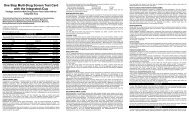Package Insert - US Screening Source
Package Insert - US Screening Source
Package Insert - US Screening Source
Create successful ePaper yourself
Turn your PDF publications into a flip-book with our unique Google optimized e-Paper software.
principle of competitive binding. Drugs which may be present in the urine specimen compete againsttheir respective drug conjugate for binding sites on their specific antibody.During testing, a urine specimen migrates upward by capillary action. A drug, if present in the urinespecimen below its cut-off concentration, will not saturate the binding sites of its specific antibody. Theantibody will then react with the drug-protein conjugate and a visible colored line will show up in the testline region of the specific drug strip. The presence of drug above the cut-off concentration will saturate allthe binding sites of the antibody. Therefore, the colored line will not form in the test line region.A drug-positive urine specimen will not generate a colored line in the specific test line region of the stripbecause of drug competition, while a drug-negative urine specimen will generate a line in the test lineregion because of the absence of drug competition.To serve as a procedural control, a colored line will always appear at the control line region, indicatingthat proper volume of specimen has been added and membrane wicking has occurred.REAGENTSThe test contains a membrane strip coated with drug-protein conjugates (purified bovine albumin) on thetest line, a goat polyclonal antibody against gold-protein conjugate at the control line, and a dye padwhich contains colloidal gold particles coated with mouse monoclonal antibody specific to Amphetamine,Cocaine, Methamphetamine, Methylenedioxymethamphetamine, Morphine, THC, Phencyclidine,Benzodiazepine, Methadone, Barbiturate or Tricyclic antidepressant.PRECAUTIONS• For healthcare professionals including professionals at point of care sites.• For in vitro diagnostic use only. Do not use after the expiration date.• The test card should remain in the sealed pouch until use.• All specimens should be considered potentially hazardous and handled in the same manner as aninfectious agent.• The used test card should be discarded according to federal, state and local regulations.STORAGE AND STABILITYStore as packaged in the sealed pouch at 2-30°C. The test strip is stable through the expiration dateprinted on the sealed pouch. The test strips must remain in the sealed pouch until use. DO NOTFREEZE. Do not use beyond the expiration date.SPECIMEN COLLECTION AND PREPARATIONUrine AssayThe urine specimen must be collected in a clean and dry container. Urine collected at any time of the daymay be used. Urine specimens exhibiting visible precipitates should be centrifuged, filtered, or allowed to settleto obtain a clear specimen for testing.Specimen StorageUrine specimens may be stored at 2-8°C for up to 48 hours prior to testing. For prolonged storage,specimens may be frozen and stored below -20°C. Frozen specimens should be thawed and mixed wellbefore testing.MATERIALSMaterials Provided• Integrated E-Z Split Key Cup with multi-drug card• Key• Security seal label• <strong>Package</strong> insertMaterials Required But Not Provided• Timer• External controlsDIRECTIONS FOR <strong>US</strong>EAllow the test card, urine specimen, and/or controls to equilibrate to room temperature (15-30°C)prior to testing.1. Bring the pouch to room temperature before opening it. Remove the cup from the sealed pouch anduse it as soon as possible.2. Donor provides specimen and secures the cap by pressing down on all three corners.3. Technician checks cap for tight seal. Technician dates and initials the security seal and attaches thesecurity seal over the cup cap.4. On a flat surface, technician pushes key to a fully closed position.5. Peel off the label on the multi-drug test card to view results. The test is read in the reaction well.6. Start the timer and wait for the red lines to appear. The results should be read at 5 minutes. Do notinterpret results after 10 minutes. See the illustration below. For detailed operation instructions,please refer to the Procedure Card.INTERPRETATION OF RESULTS(Please refer to the illustration above)NEGATIVE:* Two lines appear. One red line should be in the control region (C), and another apparentred or pink line adjacent should be in the test region (Drug/T). This negative result indicates that the drugconcentration is below the detectable level.*NOTE: The shade of red in the test line region (Drug/T) will vary, but it should be considered negativewhenever there is even a faint pink line.POSITIVE: One red line appears in the control region (C). No line appears in the test region(Drug/T). This positive result indicates that the drug concentration is above the detectable level.INVALID: Control line fails to appear. Insufficient specimen volume or incorrect procedural techniquesare the most likely reasons for control line failure. Review the procedure and repeat the test using a newtest panel. If the problem persists, discontinue using the lot immediately and contact your local distributor.QUALITY CONTROLA procedural control is included in the test. A red line appearing in the control region (C) is considered aninternal procedural control. It confirms sufficient specimen volume, adequate membrane wicking andcorrect procedural technique.Control standards are not supplied with this kit. However, it is recommended that positive and negativecontrols be tested as good laboratory practice to confirm the test procedure and to verify proper testperformance.LIMITATIONS1. The One Step Multi Drug Screen Test Card with the integrated cup provides only a qualitative,preliminary analytical result. A secondary analytical method must be used to obtain a confirmed result.Gas chromatography/mass spectrometry (GC/MS) is the preferred confirmatory method. 3,4,72. There is a possibility that technical or procedural errors, as well as other interfering substances in theurine specimen may cause erroneous results.3. Adulterants, such as bleach and/or alum, in urine specimens may produce erroneous resultsregardless of the analytical method used. If adulteration is suspected, the test should be repeated withanother urine specimen.4. A Positive result does not indicate level or intoxication, administration route or concentration in urine.5. A Negative result may not necessarily indicate drug-free urine. Negative results can be obtained whendrug is present but below the cut-off level of the test.6. Test does not distinguish between drugs of abuse and certain medications.7. A positive test result may be obtained from certain foods or food supplements.PERFORMANCE CHARACTERISTICSAccuracyA side-by-side comparison was conducted using the One Step Single Drug Test Card and commerciallyavailable drug rapid tests. Testing was performed on approximately 300 specimens per drug typepreviously collected from subjects presenting for Drug Screen Testing. Presumptive positive results wereconfirmed by GC/MS. The following compounds were quantified by GC/MS and contributed to the total amountof drugs found in presumptive positive urine samples tested.TestCompounds Contributed to the Totals of GC/MSAMPAmphetamineBARSecobarbital, Butalbital, Phenobarbital, PentobarbitalBZOCOCTHCMTDmAMPMDMAOPIOxazepam, Nordiazepam, a-OH-Alprazolam,DesalkylflurazepamBenzoylecgonine11-nor 9-carboxy-delta-9-tetrahydrocanabinolMethadoneMethamphetamineD,L Methyelnedioxymethamphetamine, MethylenedioxyamphetamineMorphine, CodeinePCPTCAPhencyclidineAmitriptyline, Desipramine, Doxepin, Desmethyldoxepin, Nortriptyline,The following results are tabulated from these clinical studies:%Agreement with Commercial KitAMP BAR BZO COC THC MTDPositiveAgreement97% >99% 90% 95% 98% 99%NegativeAgreement100% >99% 97% >99% 100% >99%TotalResults98% 99% 94% 98% 99% >99%PositiveAgreementNegativeAgreementTotalResultsPositiveAgreementNegativeAgreementTotalResultsPositiveAgreementNegativeAgreementTotalResultsmAMP MDMA MOP OPI PCP TCA*98% 100% 100% >99% 98% 95%100% 99% 100% >99% 100% >99%99% 99% 100% >99% 99% 99%%Agreement with GC/MSAMP BAR BZO COC THC MTD97% >99% 96% 96% 97% 99%95% >99% 96% >90% 88% >94%96% 99% 96% 93% 91% >96%mAMP MDMA MOP OPI PCP TCA*99% 96% 100% >99% 100% >99%94% 98% 94% >90% 97% 89%96% 97% 97% >95% 98% 91%Forty (40) clinical samples for each drug were run using each of The One Step Single Drug Test Strip byan untrained operator at a Professional Point of Care site. Based on GC/MS data, the operator obtainedstatistically similar Positive Agreement, Negative Agreement and Overall Agreement rates as trained laboratorypersonnel.*Note: TCA was based on HPLC data.PrecisionA study was conducted at three physician offices by untrained operators using three different lots ofproduct to demonstrate the within run, between run and between operator precision. An identical panel ofcoded specimens, containing drugs at the concentration of ± 50% and ± 25% cut-off level, was labeled,blinded and tested at each site. The results are given below:AMPHETAMINE (AMP)Amphetamine n per Site A Site B Site CConc. (ng/mL) site - + - + - +0 15 15 0 15 0 15 0500 15 15 0 15 0 14 1750 15 13 2 11 4 11 41,250 15 6 9 4 11 4 111,500 15 2 13 1 14 1 14COCAINE (COC)Benzoylecgonine n per Site A Site B Site CConc. (ng/mL) site - + - + - +0 15 14* 0 15 0 15 0150 15 14 1 15 0 14 1225 15 4 11 5 10 8 7375 15 0 15 0 15 0 15450 15 0 15 0 15 1 14*Note: One invalid result was obtainedBARBITURATES (BAR)






